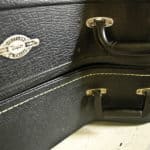You have probably wondered why it’s so important to keep your guitar in its case, and there are many reasons for this.
Not only is it useful when you transport your instrument, but it also protects it from dust and weather changes.
Being made primarily of wood, guitars are affected by the heat of the sun or the temperature of the place where they are stored.
Nevertheless, is that really harmful to the instruments? How dangerous can it be for them?
Exposing the guitar to extreme heat, for long periods of time or recurrently can strongly damage it. Mainly in acoustic guitars, the wood can be ruined and the glue can be weakened causing serious damage.
However, there are several ways to avoid this and as we are here to help you we will explain how damaging heat can be to your instruments.
Throughout this article, we will provide reasons why this happens as well as solutions and tips for you to keep your guitar healthy and functional.
Is heat dangerous for a guitar?
The main element in the construction of this instrument is and has always been wood.
Being a natural component, it reacts differently if exposed to volatile weather conditions.
In the case of high temperatures, not only the wooden section will be affected but also glued parts and strings.
In the first place, the heat dries the wood making it brittle and prone to break easier plus can produce shrinking in the body, neckpiece and fretboard.
The same will occur with the glue, it will be fragile causing the components to fall off.
Strings left in a hot environment also suffer, they will lose tension which can cause neck relief, and also their playability and durability can be affected.
These are truly important aspects to bear in mind because the more your guitar is exposed to the heat, the more weakened will be over time.
After a couple of weeks, you will notice how strong hot weather impacts your guitar.
Although their main impact will be noticed in the performance, the look can be damaged as well.
Extreme heat hitting straight in a guitar can ruin the finish of the instrument, provoking the paint to peel off which is harmful due to it works as a protective layer on the body and guitar neck.
As you may notice, extreme temperatures can hurt your instrument so badly.
Therefore, we can say that heat exposure is dangerous for guitars and other wooden instruments.
Is heat equally dangerous for acoustic and electric guitars?
Heat will affect your guitar for sure no matter if it is acoustic or electric but it is true that the latter can stand temperatures changes better.
The acoustic guitars suffer more from exposure to heat and the reason relies on the wood employed in their crafting.
While electric guitars present larger and thicker pieces of wood, the acoustic ones have thinner wood which makes them less tolerant to heat.
In addition to that, acoustic guitars have more of their components fixed with glue, plus the bridge and neck are stuck to the body using this material which is really affected by heat.
Although electric guitars present more solid wood, the rest of their sections are also influenced by high temperatures.
However, I would say that the ones that suffer more and in a shorter time are acoustic pieces.
How much heat is too much heat for a guitar?
Despite hot places being relevant for any kind of guitar, is important to bear in mind more factors such as humidity (more on that later!).
Therefore, you might wonder how much heat is harmful to your instrument, and having clarified the humidity issue we can continue.
A good condition for your guitar will be an environment between 65° and 70°F, more than that number will be not recommendable.
Of course, this condition won’t be always like that and your guitar may be sometimes exposed to heat, just think twice when leaving the instrument in the trunk of your car on a hot day, near the radiator in your room, or in constant exposure to sunlight.
What effects can heat exposure have on an acoustic guitar?
As mentioned above, acoustic guitars are more vulnerable to high temperatures and that’s because of their materials.
The most important problem would be the glue issue.
When exposed to strong heat, the glue used to fix the parts gets weaker, provoking the different pieces such as the bridge to fall off.
But that’s not all, as the neck is also glued exposing it to extreme heat could end up ruining your guitar.
What is more, extreme temperatures can cause the fretboard to shrink, and the neck could warp.
Although is not as harsh as the glue problem, heat can damage the finish of your guitar causing cracking in the wood.
What effects can heat exposure have on an electric guitar?
Unlike its acoustic counterparts, the wood of the electric guitar does not suffer as much from temperature changes as the former.
That’s because electric guitars usually have their necks fixed using screws rather than glue.
Nevertheless, some pieces have their necks glued and could experience similar glue problems to acoustic guitars.
The inconveniences are the same, in this case, frets are glued so they might be affected but it is not as common or problematic as in acoustics.
What does happen is that the fingerboard could also shrink and the neck warp due to hot environments.
The strings can perhaps be the most affected component, as they get weakened by the heat, the loss of tension also influences the instrument’s performance.
Last but not least, electric guitars present several metal components that contract and expand when exposed to extreme temperatures.
These constant changes will for sure affect your guitar stability and tuning in the long run.
How can you prevent damage from heat exposure?
Although it may seem silly, the most important thing is to avoid leaving your instrument in straight contact or near heat sources.
If you have a heater or radiator in your room, the guitar should be far from it.
In addition to that, is always recommended to keep the instrument in its case.
In that way will be protected (or less affected) from heat, cold, humidity, or even dust and dirt.
If you are a musician transporting your guitar is something you can’t avoid but there are some options to keep your instrument safe.
For instance, if you leave the guitar in the car or any hot environment, let the instrument in the case for some time to cool down before playing it.
By doing that, the wooden piece will get accustomed to the new temperature.
You will be preserving your guitar and I guarantee you will notice more tuning stability.
Be extra careful with the sun, sometimes we don’t realize it and spend hours playing under the sunlight.
If the guitar is exposed for long periods it can be damaged.
Finally, the case is the shelter of any musical instrument so a hard case will be for sure the best option not only for keeping your guitar away from heat but also for transporting it.
Although hard cases are difficult to afford due to their price, they last for a lifetime and are totally worth it.
Can heat damage be repaired on a guitar?
Each case is different so it will always depend on how damaged the guitar is. For example, if it’s a problem regarding frets they will need to be reset and adjusted.
When it comes to a warped neck of something of that kind the repairment will be tougher but still possible.
On some occasions, if the warp is not excessive it may be repaired by readjusting the truss rod and making it straight.
However, in cases where the warp is too bad, you will need to sand the neck or go get a new one.
Whatever the case, it is always advisable to visit a luthier or technician, they are experts and will know which of the available options is the best for your problem.
Humidity is also important for guitars
Heat is not the only weather factor affecting guitars, humidity also plays a relevant role in them.
These two conditions have to coexist and get on well when it comes to caring for the instrument.
Too extreme conditions, whether heat or humidity, could damage the instrument. With hot temperatures, the humidity tends to reduce provoking the wood to dry and crack.
This problem mostly affects acoustic guitars rather than electrics due to their thin wood.
Therefore, what you can do to avoid this lack of humidity is get a device called a humidifier.
Its usage simply consists of placing it where the instrument is going to be stored and that’s it.
As a matter of fact, humidity varies from one place to another so in some areas won’t be necessary but if you live in dry areas, a humidifier is suggested.
Moreover, some other products can also help you fight against humidity.
You can easily get some protective oils and conditioners that are not expensive at all plus don’t need to be applied more than once per year.

Hello there, my name is Ramiro and I’ve been playing guitar for almost 20 years. I’m obsessed with everything gear-related and I thought it might be worth sharing it. From guitars, pedals, amps, and synths to studio gear and production tips, I hope you find what I post here useful, and I’ll try my best to keep it entertaining also.





